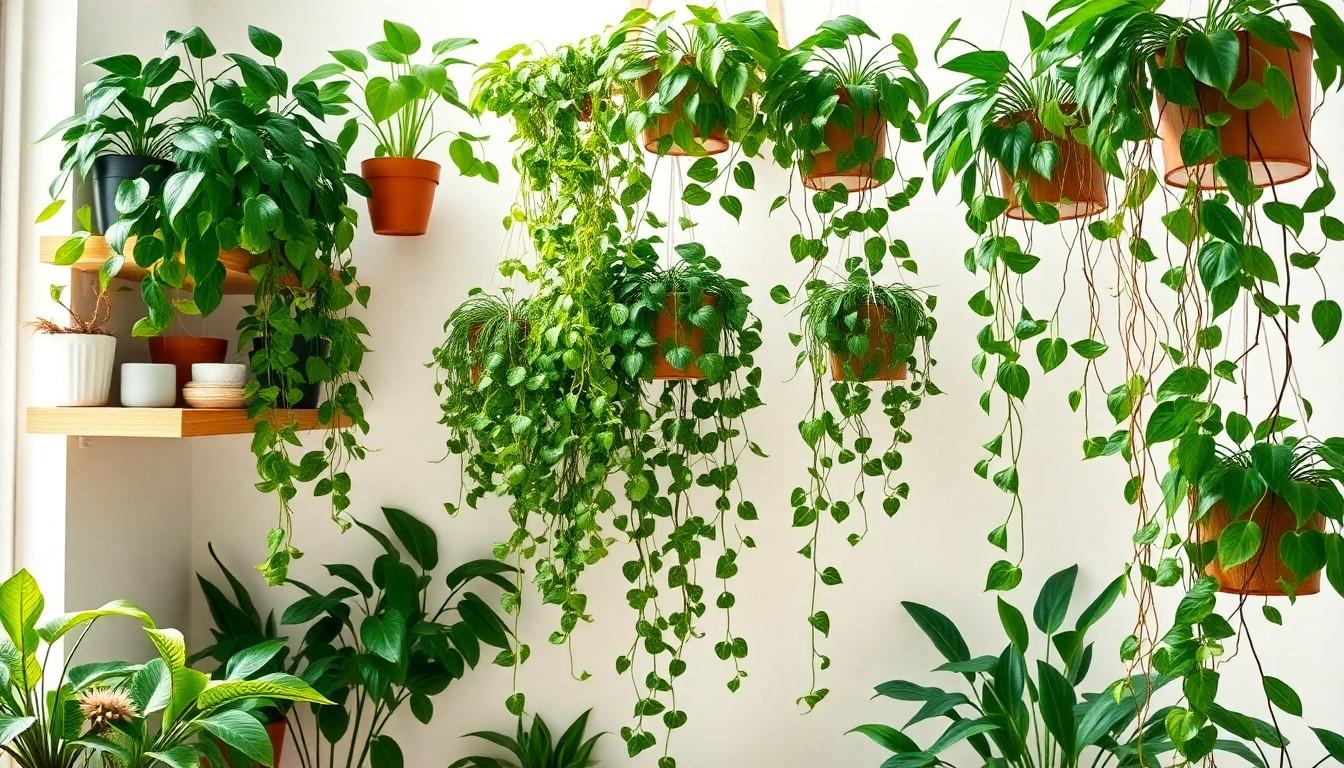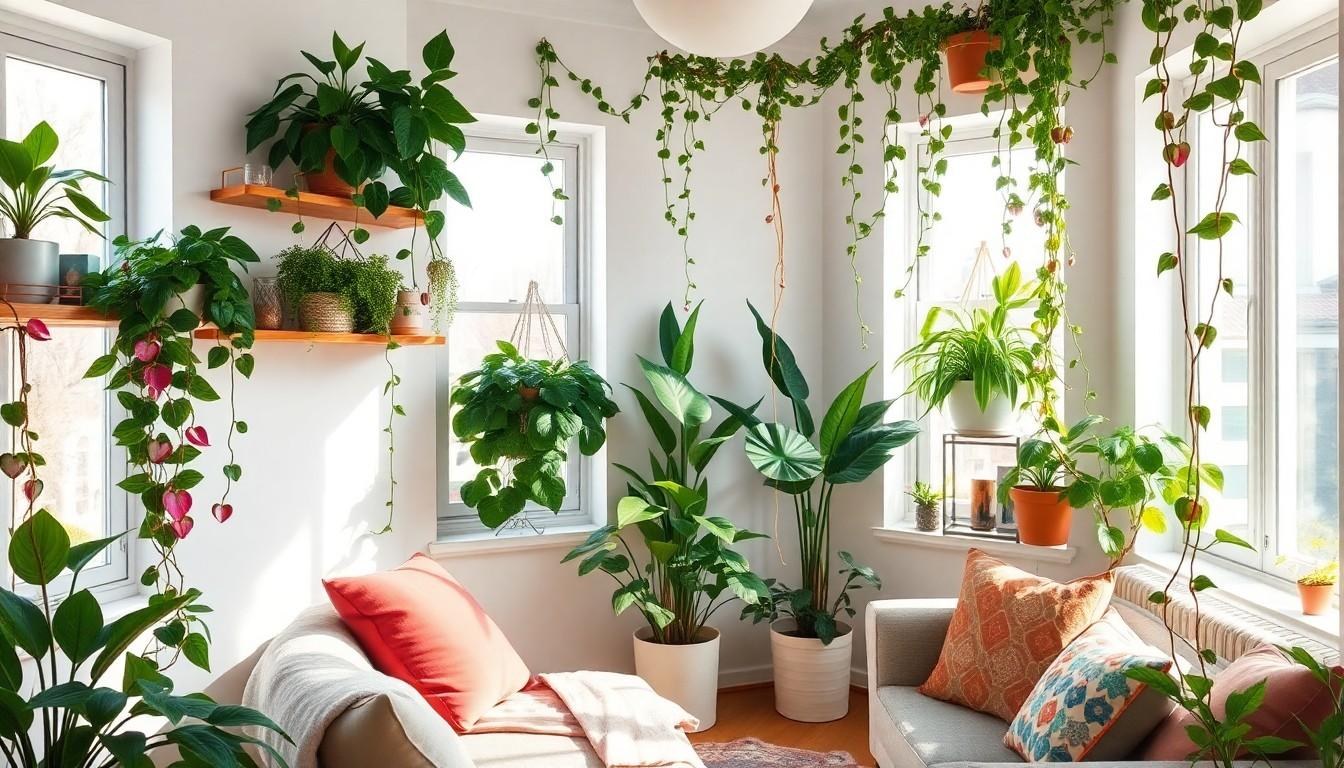Indoor spaces often crave a touch of nature, and trailing plants might just be the perfect solution. These delightful green companions not only add a splash of life but also bring a sense of tranquility to any room. Imagine lush vines cascading from shelves or elegantly draping over windowsills, creating a mini jungle right in your living room. Who wouldn’t want that?
Benefits Of Trailing Plants Indoor
Trailing plants offer numerous benefits that enhance indoor environments. These advantages extend from their aesthetic appeal to practical benefits like air quality improvement and space optimization.
Aesthetics And Decor
Enhancing the visual appeal of indoor spaces is one of the primary benefits of trailing plants. Graceful vines can drape elegantly from shelves or hang in decorative pots, adding depth and dimension to any room. With various textures and colors, these plants create a lush atmosphere, transforming ordinary spaces into dynamic green retreats. Trailing plants invite a sense of tranquility, making living areas feel more inviting and comfortable. The diversity of species allows for personal expression in decor, enabling individuals to choose plants that reflect their unique style.
Air Quality Improvement
Improving indoor air quality is another significant advantage of trailing plants. Plants naturally filter harmful toxins, such as formaldehyde and benzene, present in household items. NASA’s Clean Air Study found that specific varieties, including pothos and spider plants, excel in purifying the air. Through photosynthesis, trailing plants release oxygen, contributing to a healthier environment. Incorporating these plants indoors results in fresher air, promoting better well-being for occupants. Regularly maintaining trailing plants ensures they effectively carry out their air-cleaning abilities.
Space Optimization
Optimizing space usage is crucial in smaller living areas, and trailing plants excel in this regard. Vertical gardening allows for creative use of wall space, freeing up surfaces for other purposes. Hanging planters can transform empty corners into vibrant focal points without taking up valuable floor space. Utilizing height with trailing plants maximizes light exposure while enhancing overall aesthetics. Incorporating these plants into decor elevates the design while ensuring efficient space management.
Popular Types Of Trailing Plants Indoor

Trailing plants enhance indoor spaces and provide an array of options that suit any home decor style. Here are some popular choices for indoors.
Pothos
Pothos stands out for its adaptability and resilience. It thrives in various lighting conditions, from low to bright indirect light. The heart-shaped leaves come in shades of green and variegated patterns, adding visual interest. In addition, this plant requires minimal care, making it ideal for beginners. Allow the soil to dry between waterings, and Pothos can flourish for years. Its trailing vines can reach lengths of several feet, making it perfect for hanging pots or cascading from shelves.
String Of Hearts
String of Hearts captivates with its delicate, heart-shaped leaves on slender, trailing stems. This succulent prefers bright, indirect light, promoting vibrant growth. With proper care, the stems can grow up to three feet long, creating an enchanting drape. Soil should be well-draining, and watering should be infrequent, allowing the soil to dry out completely. This plant adds a romantic touch to any space while being relatively low maintenance, making it a popular choice for plant enthusiasts.
Philodendron
Philodendron offers a diverse range of species, many of which feature charming trailing habits. They are known for their glossy green leaves and vigorous growth patterns. Most Philodendrons thrive in moderate to bright indirect light, ensuring lush foliage development. Watering should occur when the top inch of soil feels dry, adapting to individual preferences. Some varieties, such as the Heartleaf Philodendron, are particularly low maintenance, making them ideal for busy schedules. With their climbing nature, these plants invite a sense of lushness to any indoor setting.
Care Tips For Trailing Plants Indoor
Caring for trailing plants indoors promotes vibrant growth and sustains their beautiful appearance. Consider the following aspects for optimal health.
Light Requirements
Trailing plants generally require bright, indirect light to thrive. Pothos adapts to low light conditions, while String of Hearts flourishes in brighter settings. Philodendron benefits from filtered light, allowing its glossy leaves to shine. Overexposure to direct sunlight can cause leaf burn, so positioning them away from harsh rays is essential. Regular monitoring of light levels aids in ensuring the plants’ needs are met.
Watering Guidelines
Watering trailing plants requires careful attention to moisture levels in the soil. Checking the top inch of soil for dryness informs the watering schedule. Pothos prefers to dry out between watering, reducing the risk of root rot. Meanwhile, String of Hearts tolerates drought better than most. Philodendron enjoys consistent moisture, but it thrives just as well when slightly dry. Ensuring proper drainage is crucial for maintaining healthy roots.
Fertilization Practices
Fertilizing trailing plants supports growth and enhances foliage health. A balanced, water-soluble fertilizer every 4 to 6 weeks during the growing season works well. Pothos shows significant growth with a general-purpose fertilizer. String of Hearts requires less frequent feeding due to its low nutrient demand. Philodendron benefits from a high-nitrogen fertilizer, promoting robust leaf development. Adhering to seasonal fertilization keeps indoor trailing plants vibrant.
Common Issues With Trailing Plants Indoor
Trailing plants may face several challenges that affect their growth and appearance. Recognizing these issues early can lead to effective solutions.
Pests And Diseases
Pests like spider mites and aphids can affect trailing plants indoors. Frequent inspection of leaves helps identify infestations early. Common symptoms include yellowing leaves and webbing. Fungal diseases also pose a risk, particularly in overly humid conditions. Proper air circulation and avoiding wet foliage reduce disease occurrence. Neem oil serves as an effective treatment for most pests while being safe for plants.
Overwatering Problems
Overwatering leads to root rot, a significant threat to trailing plants. Inspecting soil moisture is essential before watering; if the top inch feels dry, it’s time to water. Roots suffocate in excessively wet soil, causing yellowing leaves and wilting. Ensuring drainage holes in pots allows excess water to escape. Additionally, using well-draining potting soil promotes healthy root development.
Light Burn
Light burn occurs when trailing plants receive too much direct sunlight. Leaves develop brown, crispy edges as a result of excess light exposure. Moving plants to a location with bright, indirect light prevents this issue. Understanding specific light requirements for each plant type promotes healthier growth. Adjusting their position based on the season can also mitigate the risk of light burn.
Conclusion
Incorporating trailing plants into indoor spaces offers a unique blend of beauty and functionality. These plants not only enhance the visual appeal of any room but also contribute to a healthier living environment. With their air-purifying qualities and adaptability to various lighting conditions, trailing plants like Pothos, String of Hearts, and Philodendron stand out as excellent choices for both novice and experienced plant enthusiasts.
Proper care ensures that these lush vines thrive and continue to transform spaces into serene havens. By following simple guidelines for watering, light exposure, and pest management, anyone can enjoy the benefits of these captivating plants. Embracing trailing plants is a step towards creating a vibrant and inviting indoor atmosphere.

